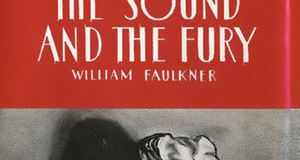Comparing Faulkner's A Rose for Emily and Porter's The Jilting of Granny Weatherall
By
2013, Vol. 5 No. 08 | pg. 1/1
KEYWORDS:
William Faulkner’s “A Rose for Emily” focuses on the life and death of Emily Grierson, a monumental figure representing the traditional South in her hometown of Jefferson, Mississippi. Although the story begins with her death, the details of her life are revealed through flashbacks by an unknown narrator. Upon the death of her father, Emily becomes confused and disoriented. She believes that her father is not dead, and to the townspeople’s dismay, refuses to permit anyone to bury him. She is ultimately “jilted” by the man she falls in love with—Homer Barron, a bold, overpowering contractor from the North—and poisons him to ensure a life-long commitment. A similar theme appears within Katherine Ann Porter’s “The Jilting of Granny Weatherall.” Ellen Weatherall, nicknamed “Granny” throughout the piece, lies upon her deathbed as the story begins. Through a technique entitled “stream of consciousness,” the narrator recounts Granny’s life and the struggles she faced as a young woman. The first of these occurred when Granny was jilted on her wedding day by her fiancé George. Although she continued on with her life—remarried, had four children, and lived to be an old woman—the loss of George continued to affect her. Then, as she took her last breath, the “bridegroom” (Jesus) betrayed her as well. While the two stories contain similar themes, both are affected by different circumstances—Emily by her overbearing and overprotective father, Granny by her first jilting. The author’s use of setting, plot, narration, flashback, conflict, symbolism, and character analyses contribute to the overall theme of each story.Within “A Rose for Emily,” the narrator describes Emily’s home as “an eyesore among eyesores…lifting its stubborn and coquettish decay” above the modernized town in which it exists (Faulkner 243). The townspeople remain skeptical of Emily throughout the story. Containing new “gasoline pumps,” “cotton wagons,” and “garages,” Jefferson continues to grow while Emily remains in the past. As the Board of Alderman came to remit Miss Emily’s taxes, they found that the home “smelled of dust and disuse—a close, dank smell,” and that the leather furniture was cracked (Faulkner 244). This “smell” also foreshadows the ending, reminding the townspeople of a tomb. The house contains a level of dust that is overbearing—it is even depicted as “patient and binding” (Faulkner 250). She died in “a heavy walnut bed with a curtain,” her head lying “on a pillow yellow and moldy with age and lack of sunlight” (Faulkner 249). Another crucial aspect is the expansion of the town. The townspeople refer to Miss Emily as a “tradition, a duty, a care,” and a “hereditary obligation,” but they are also incredibly jealous of her (Faulkner 244). Upon finding out that all she had inherited from her father was the house, they began to pity her, saying that “now she would know the old despair of a penny” (Faulkner 246). The setting in “A Rose for Emily” is used to reflect the values of the Old South versus the values of the industrialized, growing New South. As in “A Rose for Emily,” “The Jilting of Granny Weatherall” uses setting to expound upon the theme. The story begins in Granny’s bedroom, where she is sick, but ultimately takes place inside her stream of consciousness. She begins to describe her past; the children she raised, the lamps she lit, her first husband, etc. But the most important involves her first jilting by her fiancé George, and her second, by Jesus. There are three major conflicts in“A Rose for Emily:” man vs. man, man vs. society, man vs. self and man vs. supernatural. The first conflict involves man vs. man. This conflict occurs between Homer Barron and Miss Emily. Because she was unable to let go of her father’s death, Emily falls in love with Homer Barron. Homer is attracted to the male company of the town instead of her, so in order to keep him, Emily poisons him. The second conflict involves man vs. society. pThis occurs between the townspeople and Miss Emily. Because she is so old-fashioned and proper, the townspeople despise her. They continue to “pity her” throughout the story, gossiping about the way she conducts herself and the things that have happened in her life. The Board of Aldermen tried to readmit her taxes, but Emily refused to pay them. When the mailboxes went up around the town, Emily refused to hang hers. She ultimately becomes the representation of the town’s past and a monument among the “august names” in the Confederate graveyard (Faulkner 243). The third conflict involves man vs. supernatural. This occurs between Emily and her dead father. Alive, Emily’s father was overprotective, overbearing, and stubborn. He refused to let any man near Emily—there was a picture painted of the two; “We had long thought of them as a tableau, Miss Emily a slender figure in white in the background, her father a spraddled silhouette in the foreground, his back to her and clutching a horsewhip…” (Faulkner 246). Although he was only trying to protect her, this raises a question: did Emily’s father love her a bit too much? This could have been the reasoning behind poisoning Homer Barron—Emily sought a man much like her father, but was terrified of losing him. On the night he was last seen, the narrator states, “…that was to be expected too; as if that quality of her father which had thwarted her woman’s life so many times had been too virulent and too furious to die” (Faulkner 248). There are also three major conflicts within “The Jilting of Granny Weatherall:” man versus man, man versus self, and man versus supernatural. The first involves Granny and George, the first man that jilted her. Although he hurt her terribly, Granny is unable to forget him. She says, “I want him to know I had my husband just the same and my children and my house like any other woman. Tell him I was given back everything he took away and more” (Porter 767). The conflict man vs. self involves Granny and her own personal memories, which ultimately became her burden. Granny “spent so much time preparing for death [that] there was no need for bringing it up again” (Porter 764). She experienced milk-leg and double pneumonia, her daughter Hapsy died, and she was jilted at the altar by her first love. The third and final conflict involves man versus supernatural. There was “again no bridegroom and the priest in the house” (Porter 769). Once again, Granny was betrayed by someone she loved dearly—except this time it was by her God. She believes that “there is nothing more cruel than this,” and that she can “never forgive it” ( Porter 769). Helen E. Nebeker describes the point of view/narration in “A Rose for Emily” as, “…forty years of critical study of Faulkner’s short story, “A Rose for Emily,” has failed to come to grips with the problem of its narrative focus or point of view” (Nebeker). The narrator uses words like “us, we, and our”—therefore, the story is reiterated by a town member, not an uninvolved third party. Because it is told this way, the story appears biased and severely opinionated. To appreciate the narration in “The Jilting of Granny Weatherall, one must first understand the definition of “stream of consciousness.” Literary Dictionary defines stream of consciousness as “thought patterns that create the impression that the reader is eavesdropping on the flow of conscious experience in the character’s mind, gaining intimate access to their private ‘thoughts’ ” ( Literary Dictionary). An example of this within the context of the story reads, “Cornelia’s voice staggered and bumped like a car in a bad road. It rounded corners and turned back again and arrived nowhere” (Porter 768). Through the use of this technique, the reader is able to relate to the thought patterns of Granny as she lay dying. Her thoughts blur together, and it is difficult to differentiate between what is real and what is taking place in her mind. The characters within the story help define the theme as well. The most important in “A Rose for Emily” include Emily and the townspeople. Emily Grierson is described as a “small, fat woman in black with a thin gold chain descending to her waist and vanishing into her belt, leaning on an ebony cane with a tarnished gold head” (Faulkner 244). Her eyes were like two lumps of coal “pressed into a lump of dough” , and she looked like a drowned person “long submerged in motionless water” (Faulkner 244). She refuses to accept that Colonel Sartoris is dead and also refuses to pay her taxes. Emily’s relationship with her father remains a mystery—although it is suggested that the relationship was more than simply father/daughter. Therefore, the town was not shocked when Emily remained single and turned thirty. They believed themselves to be “vindicated” by it (Faulkner 246). Then Emily’s father died. She was so attached to him that she refused to believe he was dead and would not let the townspeople remove his body for three days. At this particular point, the townspeople did not believe that she was crazy, but instead “believed that she had to do that” and “she would have to cling to that which had robbed her” (Faulkner 246). Upon meeting Homer Barron, Emily began an undesirable affair. Although the townspeople were happy that Emily was involved with someone, they were confused that she was with a Northerner, being so engraved in the Old South. Emily then went to the pharmacist for poison, and the town thought she would kill herself. After purchasing the arsenic, the next time the townspeople saw Emily, “she had grown fat and her hair was turning gray” (Faulkner 248). This physical strain is due to Homer Barron’s murder and the loss of her father. Soon after--at seventy four years old--Miss Emily died in her home “on a pillow yellow and moldy with age and lack of sunlight” (Faulkner 249). The townspeople found Homer Barron in a bedroom upstairs, lying in a lover’s embrace, with the indentation of a head upon the pillow next to him and one “long strand of iron gray hair” (Faulkner 250). Ellen Weatherall—known in the story as “Granny”—is the main focus of Porter’s “The Jilting of Granny Weatherall.” Stubborn, old-fashioned, and hard working, Granny is eighty years old and on her deathbed. Aggravated with Doctor Harry—the young physician that is attending to her—, and her daughter Cornelia, she floats in and out of sub-consciousness. Reflecting on her life, she struggles with the one person who hurt her most—George. Upon her jilting at the altar, Granny became a strong, independent woman, but thoughts of him often lingered on her mind. Searching for her daughter Hapsy who passed away, Granny struggled with the thought of her loss. Then, as she passes away, Granny experiences her last—and most terrible jilting—the one made by her God. She is alone in dying, just as she was alone at the altar. The townspeople serve as both Emily’s friends and enemies. Because they remain unnamed, the individual townspeople are unimportant; as a group they are very significant. As Emily begins to date Homer Barron the townspeople were happy for her, but as the relationship progressed, everyone began thinking that it was “a disgrace and a bad example to the young people” (Faulkner 247). Plot is essential to the story’s theme as well. “A Rose for Emily” contains a confusing plot which begins at the end of the story, goes back to the middle, back to the past, and so on. The exposition—or rising action—occurs when the story opens. Here, the narrator describes Miss Emily, her home, and the situation involving her taxes. The crisis—or the point where the decisive action takes place—happens when the smell develops and Emily’s father dies. The point of greatest importance (or climax) occurs when Homer Barren comes and Emily buys the arsenic. The townspeople also assume that they were going to be married during the climax. The resolution happens when Emily dies, and the townspeople open her home, only to find Homer Barron dead in the upstairs bedroom. Had the story been told in any other way, the effect would not have been the same. The plot of “The Jilting of Granny Weatherall” also includes all elements. The exposition occurs as Granny scolds Doctor Harry and “floats” into her own sub-conscious thoughts. She begins thinking of tomorrow and the things that need to be completed, but believes that things would work out in the end. The crisis occurs as Granny remembers her first jilting and begins to think about the children when they were younger. The climax occurs as she begins to see her daughter Hapsy and also talks to her. Granny steps into a horse cart with a man that she knows—Jesus—and listens to “a thousand birds that were singing a Mass”; she was beginning to realize that it was her time to die (Porter 768). As the light began to become a point, Granny searched for her God, but could not find him. She decides that she “will never forgive it” and “blew out the light” (Porter 769). Within the two stories, a unique similarity occurs between the townspeople and Granny’s children. Cornelia believes her mother to be incapable of taking care of herself—she attends her mother as she would her children. She whispers with Doctor Harry and Father Connolly about her. In this same aspect, the townspeople find Emily incapable of taking care of herself. They gossip about her affair with Homer Barron, saying, “Poor Emily, Poor Emily” (Faulkner 247). Both women experience “jilting” as well. Emily is “jilted” by her father and Homer Barron. Because her father isolated her from society, after he died, she didn’t have anyone. She kept the house closed to visitors—as well as the women who came to console her after her father’s death. This is the driving factor that ultimately led to her poisoning Homer Barron and keeping him upstairs in her room. The cousins that the town brought to Emily made Homer leave town for a few nights, and this was her second “jilting.” Frightened by the threat of Homer leaving, Emily killed him. Both Granny’s jilting leave her with unanswered questions. Lying upon her deathbed and reflecting on her life, she remembers the man that broke her heart—George. Reliving the day, she recalls, “What does a woman do when she has put on the white veil and set out the white cake for a man and he doesn’t come” (Porter 766). She also compares it to “losing her soul in the pit of hell” and “a smoking cloud from hell” (Porter 766). Struggling with the memory of this, she is jilted once more by her God. Searching for him in the darkness of death, all she finds is her own light, which she must ultimately blow out. She says, “There is nothing more cruel than this—I’ll never forgive it” (Porter 769). Although the stories contain different conflicts, plots, and elements, the same theme exists throughout. The overprotective nature of Emily’s father leads her to be shy and reserved—frightened of standing up for herself, and careful about whom she associates with. Frightened of losing her “lover” Homer Barron, Emily poisons him and keeps him close to her for the rest of her days. In “The Jilting of Granny Weatherall,” Granny experiences two jilting that change her life forever. Although she believes the first to be the equal to hell on earth, she soon finds that the true jilting—the one made by her God—is the worst. Both stories contain their own unique “jilting” themes, and warn readers of the dangers of isolation and denial. ReferencesFaulkner, W. (2010). A Rose For Emily. In Literature Reading Reacting Writing (7th ed., pp. 243-250). Boston: Wadsworth Cengage Learning. (Original work published 1930) Porter, K. (2010). The Jilting of Granny Weatherall. In Literature Reading Reacting Writing (7th ed., pp. 763-769). Boston: Wadsworth Cengage Learning. (Original work published 1930) Mepham, John. "Stream of consciousness". The Literary Encyclopedia. First published 17 October 2003 [http://www.litencyc.com/php/stopics.php?rec=true&UID=1062, accessed 01 April 2013.] Britton, E. M. (1987). An Approach to "The Jilting of Granny Weatherall". The English Journal, 76(4), 35-39. Nebeker, H. E. (1970). Emily's Rose of Love: Thematic Implications of Point of View in Faulkner's "A Rose for Emily". The Bulletin of the Rocky Mountain Modern Language Association, 24(1), 3-13. Suggested Reading from Inquiries Journal
Inquiries Journal provides undergraduate and graduate students around the world a platform for the wide dissemination of academic work over a range of core disciplines. Representing the work of students from hundreds of institutions around the globe, Inquiries Journal's large database of academic articles is completely free. Learn more | Blog | Submit Latest in Literature |


















